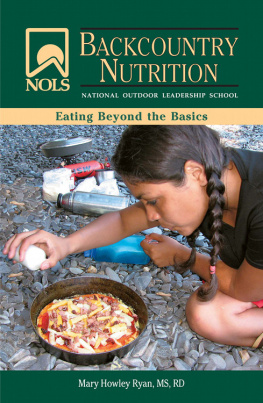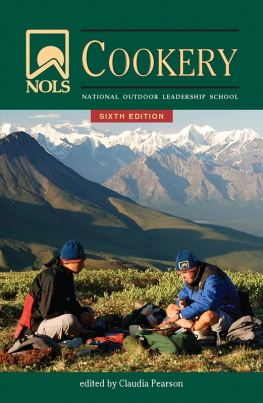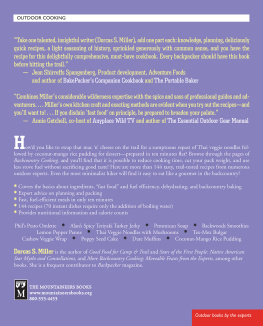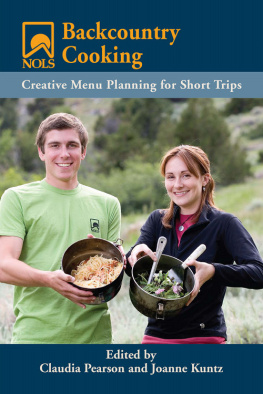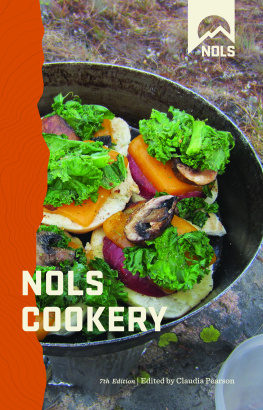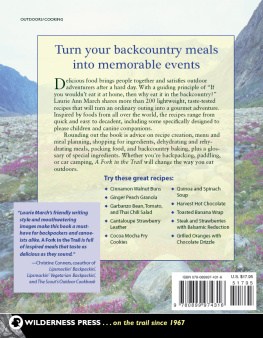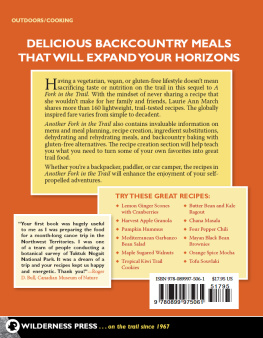
NOLS
Backcountry Nutrition
Eating Beyond the Basics
Mary Howley Ryan, MS, RD
STACKPOLE BOOKS

Copyright 2008 by The National Outdoor Leadership School
Published by
STACKPOLE BOOKS
5067 Ritter Road
Mechanicsburg, PA 17055
www.stackpolebooks.com
All rights reserved, including the right to reproduce this book or portions thereof in any form or by any means, electronic or mechanical, including photocopying, recording, or by any information storage and retrieval system, without permission in writing from the publisher. All inquiries should be addressed to Stackpole Books, 5067 Ritter Road, Mechanicsburg, Pennsylvania 17055.
Printed in the United States
First edition
10 9 8 7 6 5 4 3 2 1
The print edition of this title was manufactured to FSC and Rainforest Alliance standards using paper from responsible sources and sustainable practices.
Library of Congress Cataloging-in-Publication Data
Ryan, Mary Howley.
NOLS backcountry nutrition : eating beyond the basics / Mary Howley Ryan.
p. cm.
Includes bibliographical references and index.
ISBN-13: 978-0-8117-3505-6 (alk. paper)
ISBN-10: 0-8117-3505-2 (alk. paper)
ISBN-13: 978-0-8117-4697-7 (ebook)
1. Outdoor life. 2. Nutrition. I. Title.
TX823.R933 2008
613.2dc22
2008003806

QED stands for Quality, Excellence and Design. The QED seal of approval shown here verifies that this eBook has passed a rigorous quality assurance process and will render well in most eBook reading platforms.
All eBook files created by eBook Architects are independently tested and certified with the QED seal. For more information please see:
ebookarchitects.com/QED.php
List of Tables
I. Backcountry Nutrition Basics
1. Energy: Your Backcountry Fuel
2. Water: You Cant Live Without It
3. Carbohydrates: Your Brains Favorite Food
4. Protein: More Than Muscle
5. Fat: The Good, the Bad, and the Ugly
6. Vitamins, Minerals, and Phytonutrients: The Small Stuff That Matters
II. Putting the Nutritional Pieces Together in the Backcountry
7. Food and Mood
8. Staying Healthy and Managing Illness
9. Nutrition for Special Environments
10. Nutrition for Teens
11. Special Diets
12. Coming Home: Nutrition After Getting Out of the Field
13. For the Backcountry Professional
For Dave and Abbey, my favorite backcountry companions
Foreword
I first met Mary Howley Ryan when she enrolled in our graduate program in nutrition at the University of Utah. I soon came to realize that she was no ordinary nutrition graduate student. She had lived in a teepee and worked as a bartender before deciding to pursue a career in nutrition. Mary soon enthusiastically began to make the rounds of local grocery stores collecting unneeded food items for the homeless shelter in Salt Lake City in her old pickup truck and then began conducting cooking classes for the homeless on how to prepare sanitary and healthful meals to help prepare them for the day they would leave the shelter.
I had many discussions with Mary about another of her interests, wilderness nutrition. Mary was an avid backpacker and skier and wanted to apply her newly acquired dietetic skills to gain expertise in backcountry nutrition planning. Mary and I conducted a backcountry nutrition workshop for a Wilderness Medical Society meeting, and it was evident that she had the right stuff: the physicians loved her practical nutrition tips. As part of her graduate training, we arranged for her to visit Claudia Pearson at NOLS in Lander, Wyoming, where Mary helped evaluate some of the NOLS field menus. Mary loaded up her pickup with a laptop we loaned her, a long extension cord, and a tent, and spent the summer camped out in Claudias backyard working on the NOLS rations.
While engaged in that summer of menu analysis, Mary and Claudia discussed preparing a small handbook on backcountry nutrition planning that could fit into a backpack and would weigh less than a bar of soap. Out of this discussion came the highly acclaimed 2002 NOLS publication, NOLS Nutrition Field Guide. We used this field guide as the text for our wilderness nutrition course offered at the University of Utah. It soon became evident that many of the readers of her nutrition field guide wanted even more of her practical and easy to understand nutrition advice. I encouraged Mary to write a full-length book on the topic. There were several good outdoor cookbooks on the market, but they did not delve into the nutrition behind their recipes to the extent that we would have liked, particularly for instructing our students on the why of nutrition rather than the just the how.
The book she has written, NOLS Backcountry Nutrition: Eating Beyond the Basics, is remarkable from several aspects: it is very readable (doesnt read like a nutrition textbook!), contains sound nutrition advice and recommendations that Mary has tested herself during her backcountry excursions, and is a great how-to planning guide for the individual backpacker as well as the person in charge of planning the food for groups in the backcountry far from the closest grocery store. Her book fills a unique niche as a backcountry nutrition planners guide. The chapters are interspersed with handy tips in the form of nutrition nuggets and pithy quotes that carry the reader from one topic to another. You certainly wont find this book boring, and you may want to carry it in your backpack, even if it does weigh more than a bar of soap!
Dr. Wayne Askew, Director of the Division of Nutrition at the University of Utah
Acknowledgments
Claudia Pearson, the longtime rations department manager at NOLS Rocky Mountain, tops the list of people who motivated me to pursue this project, beginning with the first NOLS Nutrition Field Guide in 2002. Claudia has remained a source of positive energy and good ideas throughout this process, and her passion for making NOLS rations that support healthy, happy, and energetic backcountry travelerswithout sacrificing taste and creativitycontinues to inspire me as a nutrition educator and writer.
I would also like to thank Dr. Wayne Askew, Director of the Division of Nutrition at the University of Utah, for his continued encouragement and support of my nutrition endeavors. In addition to his expertise related to many backcountry nutrition topics, his enthusiasm for the subject and his sense of humor kept me in touch with the two things that helped me move forward and stay sanethinking and laughing.
Dave, my husband and my biggest fan, has shared many insights and ideas about the reality of nutrition in a variety of backcountry situations, based on his experience as a mountain guide, avid climber, backcountry skier, and mountaineer. Daves unending encouragement and creative suggestionsthe Backcountry Nutrition Pinnacle and the field tips that I call nutrition nuggets were his ideaskept me excited about this project.
Next page
